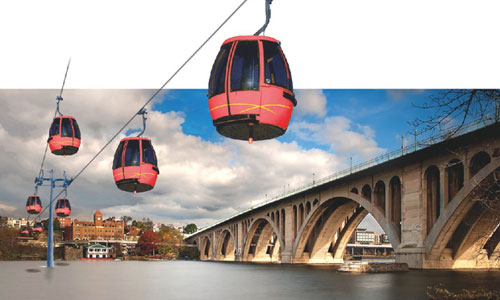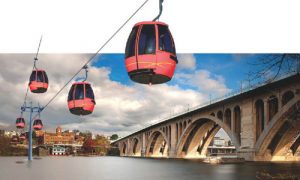On Nov. 3, the Georgetown Business Improvement District (BID) released the results of the preliminary feasibility study for a public gondola system from Georgetown to Rosslyn, showing the concept is technologically and legally viable for the area. Results were released at a public meeting in Georgetown Theater.
This summer, the project’s executive committee hired Zimmer Gunsul Frasca Architects (ZGF) who determined that a gondola to transport riders between Rosslyn and Georgetown is both legal and technically realistic, and would have a positive impact on businesses and residents of the two areas. This feasibility study is only a preliminary investigation, and does not mean that the project has been totally approved. The study estimates that, once authorized, the whole process from the start of an environmental impact study to design to construction would take 4-6 years to complete.
The ZGF team estimates that, if it is built, the gondola will have a daily ridership of about 6,500 people and would cross the Potomac River by the side of the Key Bridge in about 4 minutes, shorter than the average 15 to 20 minutes walking from the Rosslyn Metro to M Street normally takes for pedestrians.
Joe Sternlieb, CEO of the Georgetown BID, discussed what prompted the gondola’s discussion. He spoke about the importance of combating the increasing traffic congestion in the area, as well as connecting Georgetown to the rest of the city.
“We were really trying to figure out: how do we increase access [to Georgetown]?” said Sternlieb. “It’s an urban myth that Georgetown didn’t want a Metro station, [but] there were technical issues… with 1960s and 70s technology. But that doesn’t mean that, forever, Georgetown should be denied access to the regional transit network.”
The feasibility study found that the gondola system would be cheaper than trying to extend the Metro line to Georgetown and that several other cities, including Medellín, Colombia and London, England have already built such systems successfully.
The consultants suggested several locations for the Georgetown loading station, the two most feasible of which are on top of Car Barn or by the old Exxon station at the bottom of the Exorcist steps on M Street. Both spots would be easily accessible to students and deposit tourists right next to the hub of Georgetown businesses. Mary-Claire Burick, president of the Rosslyn BID, hopes the gondola will revitalize the business district surrounding the Rosslyn Metro station. But even with this new data, Burick reminded the community that the project had a long way to go before even the design could begin, including the sign off of regional political leaders and over 20 local, state, and federal agencies.
“There’s a lot of questions that still remain,” said Bruick. “The feasibility study is the first step in a long journey.”
At the first public meeting about the gondola in July 2016, residents were particularly worried about how the system would affect sightlines, though the preliminary sketches of the gondola did not seem to affect the scenery much, although the design will have to fit both Georgetown and Rosslyn’s distinctive architectural styles. A question at this most recent meeting asked about the noise that the system would produce, and the ZGF team assured the crowd that the sound from the gondolas would not significantly add much to that already produced by Key Bridge’s traffic.
Sherri Green, a Georgetown resident, says that she is happy Georgetown is looking for ways to improve and make the region more vibrant, and hopes that, if built, the gondola can bring about that change while keeping the character of the region the same.
“It’s interesting to see that it’s economically more affordable than something like a Metro station which might get a lot of snags as well,” said Green. “But, I think the interesting question will be who runs it, and how do we make it effective? And then the drop off points, how does that affect the traffic?”
Georgetown students found the proposal intriguing, although most current students will not be here when the system would be unveiled. Shannon Calahan (COL ‘19) and Isaac Karlan-Mason (SFS ‘19) both mentioned that they would continue to use the free university shuttles, GUTS buses, to get to the Metro rather than pay money for the gondola.
“[The gondola] would be a great addition to the neighborhood aesthetic that would improve traffic flow in and around Georgetown,” said Calahan. “But I personally would probably take the free GUTS instead of paying money unless it’s the weekend.”
If the gondola is approved, the first Georgetown freshman to be able to use it will not arrive for at least another six years; nevertheless, the study provides the current community an insight to future connections between Washington, D.C. and university. If regional leaders and district agencies approve the project, the NSO students of the class of 2026 may find the “Georgetown bubble” easier to break than those on campus today using the brand-new, high-flying gondola over the Potomac.





